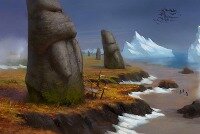
When many of us hear the word, "video games", instant visions of spikey-haired, pizza-chomping, pierced teenagers with faces glowing from large screens may be among the first thoughts to arise.
Or perhaps more innocent memories of PacMac, Pong, Space Invaders or Asteroids set in dark noisy rooms at the local shopping mall or corner pizza restaurant. Whatever your reaction, the popular notion for decades (yes, video games have been around that long now) has been that video games are somehow bad for you, brain-draining, and somehow far worse than watching television or movies. And it's not hard to understand this knee-jerk reaction, particularly given the comparatively simplistic nature of the games available during the first video games explosion of the late 1970's -- which gathered a bad rap for being viewed as centered around such activities as shooting, running, shooting some more, or just running.
Good for hand-eye coordination? Sure, maybe, but few viewed video games as a new medium with incredible promise for, of all things, brain health.
Despite the explosion of breadth, variety, depth and sophistication that has happened to video gaming in recent years, many or most still believe that video games are worthless frivolities, meaningless time-wasters, and yes -- still as bad as watching TV (or worse) when it comes to mental merits. But as soon as one digs below the surface perceptions and looks at the reality of video games today, a completely different truth emerges: video games may actually represent nothing short of the ultimate frontier when it comes to keeping one's brain sharp and healthy with aging.
It's true. Most types of video games -- from the immersive action and adventure games to Tetris to puzzle games to social 'casual' games to almost every sub-genre in between, offer brain benefits spanning a variety of areas.
And they are far better for your brain abilities than watching TV, news, movies, and even some reading -- which, depending on the content, can put your brain into something of a temporary state of disuse (hence terms like "idiot box" are surprisingly appropriate).
Before we get into the brain benefits, here's why you might care to read on in the first place: there's a video game for you out there. Plenty of games for you in fact. Yes, there are now games designed for people of (literally) all ages and genders: games for women over 40, games for men over 60, games for all ages, games for literally every interest or topic or aesthetic imaginable.

Of course, there are also brain health and aging-specific games -- from the Nintendo products such as BrainAge for the Ninentdo DS handheld device to their Nintendo Wii games console which puts your whole body into the action thanks to an innovative motion-sensing handheld controller, to web-based brain games (such as the kind here on BrainReady in our BrainFlex area) to PC/Mac-based software training programs. But part of the allure of video games, of course, is that they can be extremely fun, and highly addictive as a result. Interestingly, a big part of what makes these games fun and addictive is also what makes them good for your brain.
So why are video games good for the brain?
In short, being actively engaged in most video games actually forces you to use your brain, and often in multiple ways. They engage your brain in a combination of logic, spatial reasoning, speed-related timing, resourcefulness and creativity, short-term memory, visual acuity and, yes, physical coordination activities. And often, all at once.
Even the shoot-em-up and "twitch" games usually involve these kinds of brain function, particularly the modern story-based adventure and action games that dominate the game sales charts. Researchers at the University of Rochester found young adults who regularly played video games full of high-speed car chases and blazing gunbattles showed better visual skills than those who did not. In a second experiment, researchers found that people who do not normally play video games but were trained to play them developed enhanced visual perception.
That's right: playing a Halo or Call of Duty or World of Warcraft can actually be "good" for your brain function (subject matter aside), which, as uncomfortable as many people may feel about this fact, remember that these games represent only a tiny slice of the breadth of often wonderful, intellectually and aesthetically sophisticated, relaxing and fun other games available today.

Many have been available for years now, long forgotten by most: early immersive exploration experiences such as the Myst series (one of the first hit CD-ROM games of the early 1990's, which defied all stereotypes by appealing to men and women of literally all ages by creating a beautiful, mysterious world full of puzzles, mysteries to solve, and a compelling story) still stand the test of time and really get one to exercise their brains while relaxing in an almost meditative fashion during gameplay. Or The Dark Eye, another mid-1990's CD-ROM game with sophisticated story and aesthetics. Or Obsidian, a Myst-like experience with MENSA-level logic puzzles and mysteries to solve to unravel the bizarre realities of the Obsidian world.
Then there's the classic Tetris, a game that you may have heard of, but perhaps never played: it involves falling tile-like tetrominoes that a player must quickly maneuver so they fit into space at the bottom of the screen. In the early 1990s, Richard Haier, a professor of psychology at the University of California at Irvine, tracked cerebral glucose metabolic rates in the brains of Tetris players using PET scanners. The glucose rates show how much energy the brain is consuming, and thus serve as a rough estimate of how much work the brain is doing. Haier determined the glucose levels of novice Tetris players as their brains labored to usher the falling blocks into correct locations. Then he took levels again after a month of regular play.
Even though the test subjects had improved their game performance by a factor of seven, Haier found that their glucose levels had decreased. It appeared that the escalating difficulty of the game trained the test subjects to mentally manipulate the Tetris blocks with such skill that they barely broke a cognitive sweat completing levels that would have utterly confounded them a month earlier.
Try playing a kids game? James Gee, a professor of learning sciences at the University of Wisconsin, was profoundly humbled when he first played a video game for preschool-age kids called Pajama Sam: No Need to Hide When It’s Dark Outside. Gee’s son Sam, then 6, had been clamoring to play the game, which features a little boy who dresses up like his favorite action hero, Pajama Man, and sets off on adventures in a virtual world ruled by the dastardly villain Darkness. So Gee brought Pajama Sam home and tried it himself. “I figured I could play it and finish it so I could help Sam,” says Gee. “Instead, I had to go and ask him to help me.”
Gee had so much fun playing Pajama Sam that he subsequently decided to try his hand at an adult video game he picked at random off a store shelf—an H. G. Wells–inspired sci-fi quest called The New Adventures of the Time Machine. “I was just blown away when I brought it home at how hard it was,” he says. “I thought, ‘You can’t tell me that people go to the store and pay fifty dollars and buy this!’ Then I found out that there are billions spent each year on these games.”

Gee’s scholarly interest was also piqued. He sensed instantly that something interesting was happening in his mind as he struggled to complete the puzzles of The Time Machine. “I hadn’t done that kind of new learning since graduate school. You know, as you get older, you kind of rest on your laurels: You learn certain patterns, you know your field, and you get a lot of experience. But this requires you to think in a new way. I saw that the excitement of this is the challenge and the difficulty and the new learning. That’s what makes it fun!”
This epiphany led him to the forefront of a wave of research into how video games affect cognition. Bolstered by the results of recent laboratory experiments, Gee and other researchers have dared to suggest that gaming might be mentally enriching. These scholars are the first to admit that games can be addictive, and indeed part of their research explores how games connect to the reward circuits of the human brain. But they are now beginning to recognize the cognitive benefits of playing video games: pattern recognition, system thinking, even patience. Lurking in this research is the idea that gaming can exercise the mind the way physical activity exercises the body: It may be addictive because it’s challenging.
All of this, of course, flies in the face of the classic stereotype of gamers as attention deficit–crazed stimulus junkies, easily distracted by flashy graphics and on-screen carnage. Instead, successful gamers must focus, have patience, develop a willingness to delay gratification, and prioritize scarce resources. In other words: they have to think.
Nearly a decade after Haier’s Tetris study, Gee hit upon an explanation. He found that even escapist fantasy games are embedded with one of the core principles of learning—students prosper when the subject matter challenges them right at the edge of their abilities. Make the lessons too difficult and the students get frustrated. Make them too easy and they get bored. Cognitive psychologists call this the “regime of competence” principle. Gee’s insight was to recognize that the principle is central to video games: As players progress, puzzles become more complex, enemies swifter and more numerous, underlying patterns more subtle. Most games don’t allow progress until you’ve reached a certain level of expertise.
This is exactly the model of how Tetris works: when you first launch the game, the blocks fall at a leisurely pace, giving you plenty of time to rearrange them as they descend so they’ll fit the spaces where they fall and gradually build up a wall that fills the screen. As you get better at manipulating the blocks, the game starts dropping them at increasing speeds.
Social simulation games and beyond: the most popular games are not simply difficult in the sense of challenging manual dexterity; they challenge mental dexterity as well. The best-selling game of all time, The Sims, involves almost no hand-eye coordination or quick reflexes. One manages a household of characters, each endowed with distinct drives and personality traits, each cycling through an endless series of short-term needs (companionship, say, or food), each enmeshed in a network of relationships with other characters. Playing the game is a nonstop balancing act: sending one character off to work, cleaning the kitchen with another, searching through the classifieds for work with another.
Gee contends that the way gamers explore virtual worlds mirrors the way the brain processes multiple, but interconnected, streams of information in the real world. “Basically, how we think is through running perceptual simulations in our heads that prepare us for the actions we’re going to take,” he says. “By modeling those simulations, video games externalize how the mind works.”

Among all popular media today, video games are unique in their reliance on the regime of competence principle. Movies or television shows don’t start out with simple dialogue or narrative structures and steadily build in complexity depending on the aptitude of individual viewers. Books don’t pause midchapter to confirm that their readers’ vocabularies have progressed enough to move on to more complicated words. By contrast, the training structure of video games dates back to the very origins of the medium; even Pong got more challenging as a player’s skills improved. So yes, playing video games is one of the few ways to activate one's brain in such ways -- and for many it may be the only way.
How and where to start trying out the world of video games: most of us probably don't already play video games frequently these days, if for no other reason than the "who has the time?" excuse or "video games are for kids" notion. But now that you know that video games may be one of the best daily activities to keep your brain sharp as you age, it can be daunting to just wander into your local retailer only to be assaulted by the barrage of machines, choices, and yes -- kids. But as we've discussed in other BrainReady Blog articles, putting yourself in new and slightly uncomfortable situations is in itself wonderful for your brain. So why not embrace the new territory as a challenge, as something of a real-world video game itself?
Once you're at the store and looking around, why not throw out all notions of what is "appropriate" for your age or gender, rekindle the youthful spirit and interests you once had, and just look for something that looks interesting, fun, or pleasing in some way -- this is often the best place to start, as you will feel more motivated to actually try playing the games that you find oddly interesting or tempting and fun, rather than feeling like you have to play the predictable age-appropriate hit. From social simulations to mythical adventures that will suck you in far more than a movie or novel to puzzle games to brain games to arcade games to action games and everything in between, there IS something for literally everyone these days.
And most games are available in a format that will work on your existing computer, if you don't want to spend the money to buy a modern console game system such as the Xbox 360 or Playstation or Nintendo Wii or DS or the like. But you may find that once you start down the video gaming rabbit hole, you may have found a new exciting, engaging, relaxing, fun, and yes...brain-healthy pastime that you can enjoy for the rest of your life, any age, anytime.
Why not take a risk and give it a shot? Your brain will thank you.
(What do you think about video games and brain health? What are some of your favorite video games that you could recommend? Share & discuss by clicking the 'Comments' link below...)




